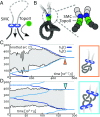Synergy of topoisomerase and structural-maintenance-of-chromosomes proteins creates a universal pathway to simplify genome topology
- PMID: 30962387
- PMCID: PMC6486742
- DOI: 10.1073/pnas.1815394116
Synergy of topoisomerase and structural-maintenance-of-chromosomes proteins creates a universal pathway to simplify genome topology
Abstract
Topological entanglements severely interfere with important biological processes. For this reason, genomes must be kept unknotted and unlinked during most of a cell cycle. Type II topoisomerase (TopoII) enzymes play an important role in this process but the precise mechanisms yielding systematic disentanglement of DNA in vivo are not clear. Here we report computational evidence that structural-maintenance-of-chromosomes (SMC) proteins-such as cohesins and condensins-can cooperate with TopoII to establish a synergistic mechanism to resolve topological entanglements. SMC-driven loop extrusion (or diffusion) induces the spatial localization of essential crossings, in turn catalyzing the simplification of knots and links by TopoII enzymes even in crowded and confined conditions. The mechanism we uncover is universal in that it does not qualitatively depend on the specific substrate, whether DNA or chromatin, or on SMC processivity; we thus argue that this synergy may be at work across organisms and throughout the cell cycle.
Keywords: Brownian dynamics; SMC proteins; entanglements; genome topology; topoisomerase.
Copyright © 2019 the Author(s). Published by PNAS.
Conflict of interest statement
The authors declare no conflict of interest.
Figures




Similar articles
-
Condensin minimizes topoisomerase II-mediated entanglements of DNA in vivo.EMBO J. 2021 Jan 4;40(1):e105393. doi: 10.15252/embj.2020105393. Epub 2020 Nov 6. EMBO J. 2021. PMID: 33155682 Free PMC article.
-
Condensins and cohesins - one of these things is not like the other!J Cell Sci. 2019 Feb 7;132(3):jcs220491. doi: 10.1242/jcs.220491. J Cell Sci. 2019. PMID: 30733374 Free PMC article. Review.
-
Condensin, cohesin and the control of chromatin states.Curr Opin Genet Dev. 2013 Apr;23(2):204-11. doi: 10.1016/j.gde.2012.11.004. Epub 2013 Jan 9. Curr Opin Genet Dev. 2013. PMID: 23312842 Review.
-
Taking cohesin and condensin in context.PLoS Genet. 2018 Jan 25;14(1):e1007118. doi: 10.1371/journal.pgen.1007118. eCollection 2018 Jan. PLoS Genet. 2018. PMID: 29370184 Free PMC article. Review.
-
The SMC complexes, DNA and chromosome topology: right or knot?Crit Rev Biochem Mol Biol. 2012 Jan-Feb;47(1):1-16. doi: 10.3109/10409238.2011.614593. Epub 2011 Sep 19. Crit Rev Biochem Mol Biol. 2012. PMID: 21923481 Review.
Cited by
-
Mitotic chromosomes.Semin Cell Dev Biol. 2021 Sep;117:7-29. doi: 10.1016/j.semcdb.2021.03.014. Epub 2021 Apr 6. Semin Cell Dev Biol. 2021. PMID: 33836947 Free PMC article. Review.
-
Chromatin Loop Extrusion and Chromatin Unknotting.Polymers (Basel). 2018 Oct 11;10(10):1126. doi: 10.3390/polym10101126. Polymers (Basel). 2018. PMID: 30961051 Free PMC article.
-
SRBD1 facilitates chromosome segregation by promoting topoisomerase IIα localization to mitotic chromosomes.Nat Commun. 2025 Feb 16;16(1):1675. doi: 10.1038/s41467-025-56911-w. Nat Commun. 2025. PMID: 39955279 Free PMC article.
-
Symmetry of loop extrusion by dimeric SMC complexes is DNA-tension-dependent.bioRxiv [Preprint]. 2024 Sep 12:2024.09.12.612694. doi: 10.1101/2024.09.12.612694. bioRxiv. 2024. PMID: 39314301 Free PMC article. Preprint.
-
Multi-contact 3C reveals that the human genome during interphase is largely not entangled.Nat Struct Mol Biol. 2020 Dec;27(12):1105-1114. doi: 10.1038/s41594-020-0506-5. Epub 2020 Sep 14. Nat Struct Mol Biol. 2020. PMID: 32929283 Free PMC article.
References
-
- Bates A, Maxwell A. DNA Topology. Oxford Univ Press; Oxford: 2005.
-
- Grosberg AY, Rabin Y, Havlin S, Neer A. Crumpled globule model of the three-dimensional structure of DNA. Europhys Lett. 1993;23:373–378.
-
- Rybenkov VV, Ullsperger C, Vologodskii AV, Nicholas R, Cozzarelli NR. Simplification of DNA topology below equilibrium values by type II topoisomerases. Science. 1997;277:690–693. - PubMed
Publication types
MeSH terms
Substances
Grants and funding
LinkOut - more resources
Full Text Sources

